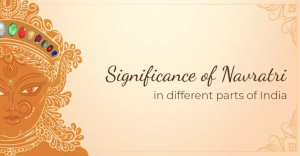Beginning Thursday, Hindus around the world will celebrate the nine-day holy festival of Navratri. According to Hindu custom, Navratri is observed four times a year, however only Chaitra and Shardiya Navratri are widely observed. While Shardiya Navaratri is often observed at the beginning of the autumn season, Chaitra Navaratri falls during the spring season. The festival of Navratri, which means “nine nights” in Sanskrit, is observed to honour the goddess Durga and her nine incarnations, known together as Navdurga.

Background of Navratri
The Navratri festival commemorates Goddess Durga’s victory over the demon Mahishasura, also known as “Asur.”
According to tradition, Mahishasura’s demand to remain eternal had been granted due of his undying devotion to Lord Brahma, but the God placed one restriction on his immortality: only a woman could kill him. However, the demon believed that he was too strong to be killed by a woman. Soon enough, Mahishasura started harassing the populace, and because of his immortality, the gods were unable to stop him.
Goddess Durga was created by Lord Vishnu, Shiva, and Brahma in order to defeat the threat posed by Mahishasura. She has several weapons at her disposal from the gods to vanquish the demon.
After a 10-day battle between Mahishasura and Goddess Durga, the demon was finally vanquished only after changing into a buffalo.
How is Navratri observed across the nation?
Every day of Navratri is linked to a different manifestation of the goddess Durga. During these nine days, people maintain ritualistic fasts, recite slokas dedicated to each goddess, wear new clothing, offer bhog, and clean their homes. They enlist the goddess’ assistance in order to enjoy successful, happy, and fulfilled lives.
Ramlila, which begins on the first day of Navratri and ends on the occasion of “Dusserah,” is organised in portions of North India, including Uttar Pradesh, Uttarakhand, Haryana, Gujarat, and Madhya Pradesh. The battle between Lord Ram and Ravan is acted out during the Ramlila, and on Dussehra night, Ravan’s effigies are set ablaze.
On the day of Vijayadashami, a procession is held in some regions of West Bengal, Odisha, Assam, and Bihar where statues of Maa Durga are submerged in a river or sea. The event is enthusiastically observed throughout most of the nation by participating in Garba and Dandiya Raas performances. While Garba is a conventional dance in which participants circle each other while clapping their hands and making rhythmic
Isn’t it amazing?


